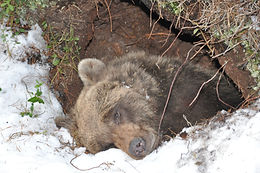Ecophysiology & Global Change

Credit: J. Painer
Global change and increasing frequency of unpredictable events appear as major threat for the vast majority of animal kingdom. There is growing interest in how well behavioural and physiological flexibility can buffer organisms from environmental hazards. Based on models of global climate change, the predicted increase of winter temperatures will act in synergy with other factors and, in the worst case, lead to countless species extinctions.
Hibernators are of particular concern, emphasising the need to determine how heterothermic species will be affected by warmer winter temperatures. Despite the fact that many seasonal hibernators will likely face negative consequences as a result of the predicted increase in environmental temperature, the ability of species to use torpor opportunistically seems to be rather beneficial when it comes to surviving temperature extremes and associated increase in food shortages.
To date, most studies addressing the impacts of climate change on heterothermy are centred at the level of the whole organism. There is, however, a clear lack of studies investigating cellular or molecular aspects in seasonal hibernators facing events associated with climate change.
Therefore, this series of projects aim at investigating the phenological shifts along with changes in physiology & behavior, and in cellular & molecular responses of heterothermic species to environmental constraints including warming winter temperatures.
The main collaborations for this research on Global Change Ecophysiology include Dr Julia Nowack (Liverpool John Moores University), Prof Alina Evans (Inland Norway University of Applied Sciences), and Prof Jérémy Terrien (CNRS Brunoy, France). This research is conducted on heterothermic species contrasting in their body size and hibernation behavior - from small dormice to large bears.
Effects of Global Warming In Small Hibernators

Credit: T. Suchanek

Credit: S. Giroud
Telomere dynamics during hibernation is positively affected by warmer winter temperatures and food availability
Master theses of Iris Tarman & Marie-Therese Ragger at the University of Natural Resources and Life Sciences (BOKU) of Vienna
Global climate change is assumed to be a significant threat to biodiversity. The expected increase in average temperature will not only lead to an increase in extreme hot temperatures in summer, but also decrease the number of cold days in winter. A large fraction of temperate zone endotherms is undergoing winter hibernation and therefore is highly sensitive to changes in environmental temperature. Higher hibernation temperatures will increase the number of interbout arousals during hibernation, and frequent arousals are expected to increased shortening of telomeres, an indicator of individual's somatic maintenance. We experimentally tested this hypothesis by comparing telomere dynamics and hibernation patterns of fat-storing hibernators that were hibernating at different temperatures with or without access to food and water. Our results show that relative telomere length was positively affected by warmer winter temperatures, even when no food was available. In contrast, hibernation at cold temperatures led to a reduction in telomere length when animals had no access to food, while individuals were able to increase telomere length when food and water were available. Our data show that hibernation at low body temperatures comes with costs on a cellular level, and that hibernators can actively counterbalance telomere shortening.
Climate & Anthropogenic Effects In Brown Bears

Credit: J. Arnemo
Effects of climate and anthropogenic disturbance on Scandinavian brown bears
PhD thesis of Alexandra Thiel at the Inland Norway University of Applied Sciences (INN)
Climate change has been described as one of the most important stressors for individuals and whole ecosystems and there is an increasing demand for a more processed-based understanding of the interplay of the physiological responses and the environmental change animals in the wild experience. The application of biologging devices, such as GPS collars and physiological sensors to collect body temperature and heart rate, facilitate the gathering of the necessary data but require the capture and handling of individuals.This PhD project aims to identify (1) the direct and indirect effects of anthropogenic disturbances on brown bears in Scandinavia. We investigate short-term effects of capture, immobilization and surgery on the circadian time-keeping of the bears’ physiology and behavior and evaluate potential long-term effects of repeated captures by investigating the patterns of epigenetic marks and the seasonal dynamic of telomere lengths. This information will aid to improve capture and handling methods to ensure optimal animal welfare. Additionally, we aim to assess (2) impacts of climate change on phenology and physiology of brown bear hibernation. The brown bear in Scandinavia hibernates on average from November to April but in which way environmental change, such as increasing ambient temperatures and decreasing snow cover, will affect the brown bear’s timing of den entry and exit as well as energy consumption during that period is yet to be explored. We use a mechanistic approach and combine microhabitat data with physiological data and metabolic rate to predict changes in phenology and energetic constraints during hibernation under future climate change scenarios.
